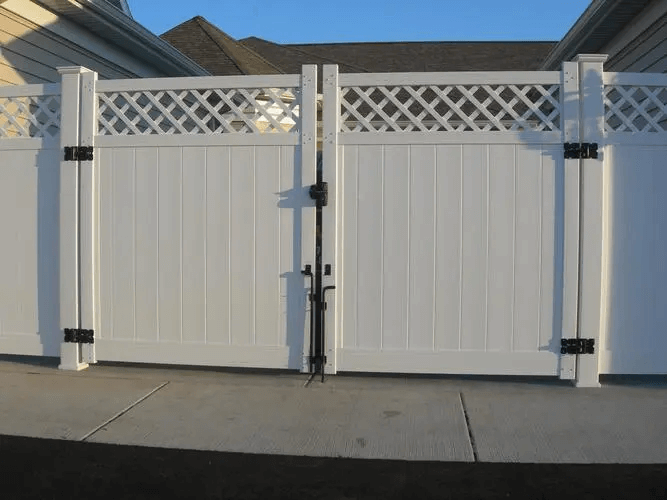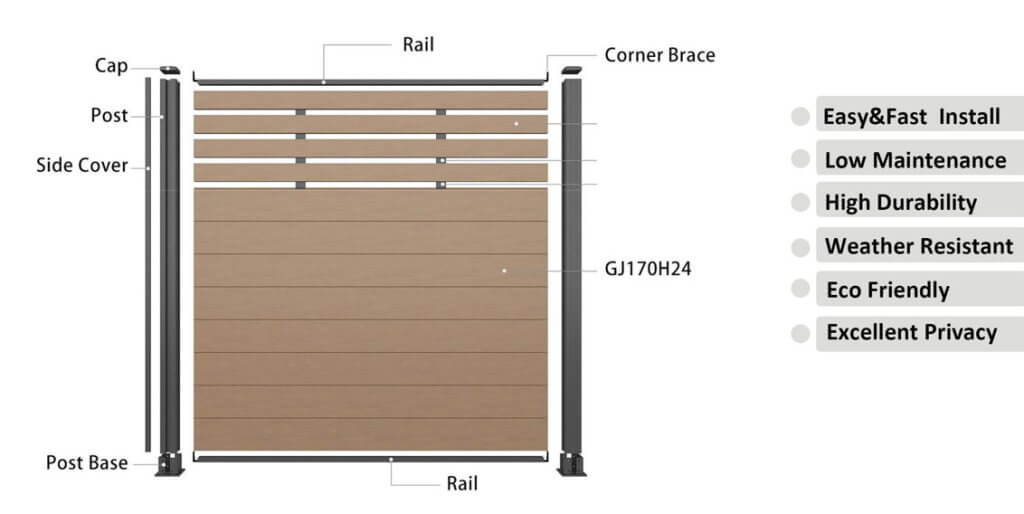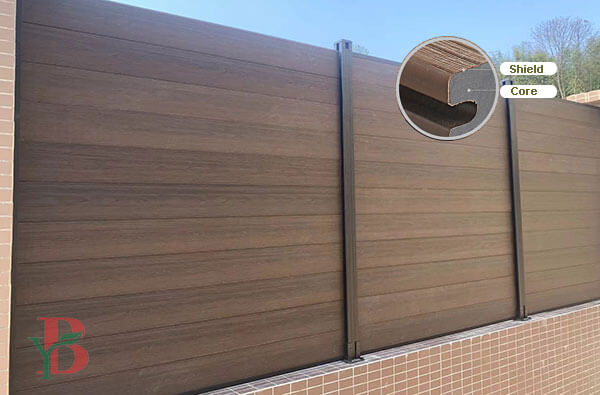When it comes to choosing the right fencing material for your property, two popular options often come to mind: composite fencing vs. vinyl fencing. Both types of fencing offer unique advantages and disadvantages, so it’s important to carefully consider your needs and preferences before making a decision. In this comprehensive comparison, we will delve into the key factors to help you choose between these two popular fencing options.
Understanding Fencing Materials: Composite fencing vs. Vinyl fencing
1.What is Composite Fencing?
Composite fencing is designed to offer the benefits of both wood and plastic, such as durability, low maintenance, and an attractive appearance. There are two main categories of composite fencing: traditional uncapped composite fencing and capped composite fencing.
Traditional Uncapped Composite fencing:
Traditional composite fencing is made from a combination of recycled wood fibers and recycled plastic. It is important distinction to note because that traditional composite fencing is uncapped.
Capped Composite Fencing:
Capped composite fencing takes the concept of traditional composite fencing a step further by adding and additional protective layer or “cap” to the surface of the fence boards. The cap is usually made of a more durable and weather-resistant material, to enhance the overall performance and lifespan of the fence. The protective cap helps to protect the fence from fading, staining, and scratching.
2.What is Vinyl Fencing?
Vinyl fencing, also known as PVC fencing, represents a modern approach to property boundaries. Made from rigid PVC resin, this synthetic material offers unique advantages for homeowners seeking a low-maintenance solution.

Key Factors to Consider When Choosing Between Composite and Vinyl Fencing
Durability and Weather Resistance
Traditional Composite fencing
Advantages:
- Withstands harsh weather conditions
- Strong resistance to rot and insects
- Good moisture damage resistance
- Handles temperature fluctuations well
- More stable than wood
Disadvantages:
- Fades with prolonged sun exposure
- Requires periodic cleaning
- Can stain without proper care
- Higher cost than traditional wood
- Less UV resistant than capped version
Capped Composite Fencing
Advantages:
- Superior UV protection
- Excellent temperature stability
- Protective shield against moisture infiltration
- Better resistance to scratching and surface damage
- Superior color retention
- Improved resistance to mold and mildew
Disadvantages:
- Highest initial cost
Vinyl fencing
Advantages:
- Excellent resistance to moisture and insects
- Virtually maintenance-free
- Good resistance to salt air in coastal areas
- Highly resistant to rot and fungal growth
- Easy to clean
Disadvantages:
- May brittle in extreme cold
- Potential for UV damage over time
- Limited style options
- Less authentic appearance
Climate Considerations:
- Hot climates: Capped composite performs best, followed by vinyl and traditional composite
- Cold regions: Both composite options outperform vinyl due to better brittleness resistance
- Coastal areas: All materials are suitable, but vinyl fencing offers best salt-air resistance
- High-humidity environments: All options resist moisture well with proper installation
Maintenance Requirements
Traditional Composite fencing
- Minimal upkeep needed
- No staining or painting required
- Simple cleaning with soap and water
- Occasional inspection recommended
- Monitor for mold or mildew
- Address stains promptly
Capped Composite Fencing
- Very low maintenance requirements
- No painting or staining needed
- Periodic cleaning recommended
- Wipe down with mild cleaner
Vinyl fencing
- Virtually maintenance-free
- Easy cleaning with basic soap solution
- No painting or sealing needed
- Quick spray-downs maintain appearance
Aesthetic Appeal and Design Options
Traditional Composite fencing
Advantages:
- Natural wood-like appearance
- Wide range of colors and textures
- Authentic grain patterns
- Premium finish options
Disadvantages:
- Colors may fade over time
- Limited modern design options
- Surface can appear less refined
- Weathering can affect appearance
Capped Composite Fencing
Advantages:
- Premium wood-grain appearance
- Superior color stability
- High-end, polished look
- Versatile color and design options
- Varied texture selections
Disadvantages:
- Higher cost for premium looks
- Less natural wood feeling than uncapped composite fencing
Vinyl fencing
Advantages:
- Clean, uniform appearance
- Multiple color choices
- Smooth finish options
- Modern design elements
Disadvantages:
- Can look artificial
- Limited color options
- Less textural interest
- May appear too uniform
Comparison Table: Composite Fencing vs. Vinyl Fencing
| Feature | Traditional Composite Fencing | Capped Composite Fencing | Vinyl Fencing |
| Material: | Wood fibers and plastic | Wood fibers, plastic, and a protective cap | PVC (polyvinyl chloride) |
| Durability: | Durable, but may be susceptible to fading and staining | More durable than traditional composite fencing and vinyl fencing; resistant to rot, decay, moisture, insects, and UV fading | Durable and long-lasting; resistant to rot, decay, moisture, and insects, but can be susceptible to UV fading |
| Maintenance: | Requires regular cleaning | Requires minimal maintenance; occasional cleaning with soap and water is sufficient | Virtually maintenance-free; occasional cleaning with soap and water is sufficient |
| Aesthetics: | Natural wood-like appearance | More natural wood-like appearance than vinyl fencing; available in a variety of colors and styles | Available in a variety of colors and styles, but typically has a more uniform appearance than composite fencing |
| Cost: | Typically less expensive than capped composite fencing and vinyl fencing | More expensive than traditional composite fencing and vinyl fencing | Typically less expensive than capped composite fencing, but costs can vary depending on the quality and brand of the materials |
| Environmental Impact: | Made from recycled wood fibers and plastic, making it a more sustainable option | More environmentally friendly than vinyl fencing, made from recycled wood fibers and plastic | Made from PVC, which is non-renewable resource and can be harmful to the environment if not disposed of properly |
Frequently Asked Questions
Which lasts longer: composite or vinyl fencing?
Capped composite fencing typically offers the longest lifespan, with enhanced protection against weather, UV rays, and physical damage. While both materials are durable, composite fencing generally maintains its appearance longer than vinyl.
Is composite fencing worth the extra cost over vinyl?
For homeowners prioritizing longevity and authentic wood appearance, composite fencing justifies its higher initial cost through superior durability and aesthetic appeal. However, vinyl fencing remains an excellent value choice for budget-conscious projects.
Can composite or vinyl fencing be recycled?
Composite fencing is made from recycled materials and can be recycled again at the end of its life. Vinyl fencing, while durable, presents more challenges for recycling and requires specific disposal methods.
Bongywood Capped Composite Fencing



Conclusion
Both composite and vinyl fencing offer distinct advantages for modern homeowners. Your choice ultimately depends on specific factors like climate, budget, and aesthetic preferences. Composite fencing, especially capped composite, provides superior durability and a more natural appearance but comes at a higher cost. Vinyl fencing offers excellent value and low maintenance requirements, but not as durable as capped composite fencing.
Consider your local weather conditions, long-term maintenance commitment, and initial budget when making your final decision. Remember that both options represent significant improvements over traditional wood fencing in terms of durability and maintenance requirements.
Ready to Transform Your Property?
Contact a Bongywood representative today to learn more about our composite fencing solutions and find the perfect option for your needs.









